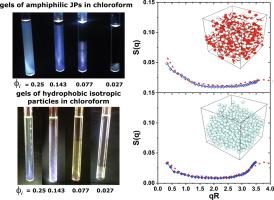Journal of Colloid and Interface Science ( IF 9.4 ) Pub Date : 2021-01-20 , DOI: 10.1016/j.jcis.2021.01.039 Denise Chirinos-Flores , Rodrigo Sánchez , Pedro Díaz-Leyva , Anna Kozina

|
Hypothesis
The anisotropic nature of colloidal particles results in orientation-dependent interactions that organize the particles into peculiar structures different from those formed by isotropic colloids. Particles with a hydrophilic hemisphere are expected to assemble in hydrophobic solvents due to the contribution of hydrophobic interactions as observed for molecular amphiphiles.
Experiments
Asymmetrically decorated silica-based Janus particles are dispersed in an apolar solvent, chloroform, and their structure and dynamics are studied by light scattering and compared with computer simulations.
Findings
Gelation of amphiphilic Janus particles with asymmetric surface decoration is observed in a hydrophobic medium. The influence of particle asymmetry on gel structure and dynamics is discussed. Unlike particles with long-range repulsive interactions in water, these systems rapidly form rather compact structures that are nevertheless more ramified than those made of isotropic hydrophobic particles. Comparison with computer simulations allows visualization of the gel and reveals a contribution of asymmetric short-range attractions and cross-term repulsions to the net effective interaction potential.
中文翻译:

在非极性介质中两亲性janus颗粒的凝胶化
假设
胶体颗粒的各向异性性质导致取向相关的相互作用,该相互作用将颗粒组织成与各向同性胶体形成的结构不同的特殊结构。由于对分子两亲性观察到的疏水相互作用的作用,具有亲水性半球的颗粒有望在疏水性溶剂中聚集。
实验
装饰不对称的二氧化硅基Janus颗粒分散在非极性溶剂氯仿中,并通过光散射研究了其结构和动力学,并与计算机模拟进行了比较。
发现
在疏水介质中观察到具有不对称表面装饰的两亲Janus颗粒的凝胶化。讨论了颗粒不对称性对凝胶结构和动力学的影响。与在水中具有长程排斥性相互作用的粒子不同,这些系统迅速形成相当紧凑的结构,但与由各向同性疏水性粒子制成的结构相比,其结构更加分支。与计算机模拟的比较可以使凝胶可视化,并揭示了不对称的短程吸引力和交叉排斥力对净有效相互作用电位的影响。











































 京公网安备 11010802027423号
京公网安备 11010802027423号